Virtual Book Tour: Zarina Zabrisky

HTMLGIANT welcomes Zarina Zabrisky, author of the novel We, Monsters (2014, Numina Press). In the novel, a wife and mother searches the internet for a job as a dominatrix. She needs the experience; it’s research for a novel she’s writing about her dead sister. Taking the name Mistress Rose, she learns the darkest desires of the human psyche while slowly doubting her own perception of reality. Rose’s manuscript ends up in the hands of clinical psychologist Dr. Michael H. Strong, who adds footnotes in which he analyzes Mistress Rose’s behaviors and undoing.
As part of her virtual book tour, Zarina gives you a “Top Ten” list of what she did to write We, Monsters. The novel took seven years’ worth of research to complete:
1. Read and re-read the major works of Freud and Nietzsche. I felt that I didn’t understand most of it but loved the process. Read and analyzed articles and research work by modern psychologists to feel the style.
2. Studied Diagnostic Criteria from DSM-IV-TR (the major directory for psychiatrists). Diagnosed myself with each and every disorder and affliction.
3. Composed a glossary of Paraphilia terms.
 4. Wrote a fake philosophy book from the point of view Dr. Michael H. Strong to master his personal writing style. The book is called Survival and Procreation. The world will never see it.
4. Wrote a fake philosophy book from the point of view Dr. Michael H. Strong to master his personal writing style. The book is called Survival and Procreation. The world will never see it.
5. Worked as an apprentice dominatrix at a small dungeon in Oakland (for six months). It is the only job I got fired from (for insisting on wearing rubber gloves…)
6. Studied (and failed) a manual on knot-making for bondage. I suck at knots.
7. Studied architecture books and photographs on the Potemkin Stairs and the Odessa Opera Theater (I have never been inside) to create an accurate setting.
8. Watched Battleship Potemkin in detail and many documentaries about it. Cried every time.
9. For a year, studied (almost non-existent) works on female sexual fantasies. Discovered that unlike male sexual fantasies, those are astonishingly under-studied. Also, discovered that women have very diverse sexual fantasies and some elements that appeal to some women might never occur to others (kitchen objects and agricultural items, for instance, have never crossed my mind. I am not a good housewife.)
10. Learned the rules and played Lemmings, a computer game not known to me—as pretty much every other computer game still unknown to me. Lemmings are cute.
You can purchase We, Monsters here.
***
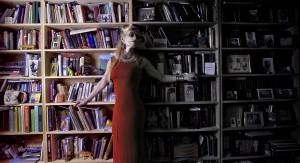 Zarina Zabrisky is the author of short story collections IRON (2012, Epic Rites Press), A CUTE TOMBSTONE (2013, Epic Rites Press), a novel We, Monsters (2014, Numina Press), and a book of poetry co-authored with Simon Rogghe (forthcoming in 2014 from Numina Press). Zabrisky started to write at six. She earned her MFA from St. Petersburg University, Russia, and wrote while traveling around the world as a street artist, translator, and a kickboxing instructor. Her work appeared in over thirty literary magazines and anthologies in the US, UK, Canada, Ireland, Hong Kong, and Nepal. A three-time Pushcart Prize nominee and a recipient of 2013 Acker Award for Achievement in The Avant Garde, Zabrisky is also known for her experimental Word and Music Fusion performances.
Zarina Zabrisky is the author of short story collections IRON (2012, Epic Rites Press), A CUTE TOMBSTONE (2013, Epic Rites Press), a novel We, Monsters (2014, Numina Press), and a book of poetry co-authored with Simon Rogghe (forthcoming in 2014 from Numina Press). Zabrisky started to write at six. She earned her MFA from St. Petersburg University, Russia, and wrote while traveling around the world as a street artist, translator, and a kickboxing instructor. Her work appeared in over thirty literary magazines and anthologies in the US, UK, Canada, Ireland, Hong Kong, and Nepal. A three-time Pushcart Prize nominee and a recipient of 2013 Acker Award for Achievement in The Avant Garde, Zabrisky is also known for her experimental Word and Music Fusion performances.
250 Points: The Hobbit pt 2: The Desolation of the Hobbit
- I missed The Hobbit: The Desolation of Smaug in theaters. Obviously since I wrote so much about the last one, I considered seeing its follow-up on more than one occasion, but just couldn’t summon the energy, even though a good friend invited me to join her, promising she’d bring snacks from Trader Joe’s.
- And then a few days after that, while I was out strolling the boulevard, I passed another friend who was en route to see the thing, on a lazy, chilly Sunday afternoon. But instead of joining him, I went home and took a bath.
- So you can see how excited I was to watch this movie. Please keep that in mind as you read this.
- Then the film left theaters, and I realized I’d missed my one and only chance for all time. I rushed to my local multiplex and pleaded with its employees to give me a private screening, but they refused, and threatened to call the police. Again.
- I despaired, and spent a week wondering what had happened to Bilbo, and Gandalf, and Thorin, and Whorin, and Hewy, and Dewy, and Chewy, and Killy, and Thrilly, and Culty, and the ninety-seven other little dwarves, and everyone else in Middle-earth.
- Suddenly, just when I could no longer bear the suspense, a CGI moth flew through my window, gripping an AVI copy of the film in its fuzzy mandible. It landed on my shoulder and mumbled something about how Gandalf was in trouble and “needed me.”
- Well, I need you, too, Gandalf! So I decided to watch the movie, after all, and take a lot of notes.
- These are my notes.
- It’s been fifteen long months since I watched An Unexpected Journey, and I barely remember anything that happened in it.
- It occupied a tremendous number of minutes? And presented a great many wolves and goblins that were born in a super-computer’s digital bowels?
- I do recall that the movie featured at least one terrific scene: the riddle game between Bilbo and the creature known as Gollum.
- Gollum won’t be in this new film, I have heard, which is a minus going in.
- Even still, I have no doubt that this movie will do its best to amuse and delight us, because that is how capitalism works. So let’s get right to it! READ MORE >
Some Poems…
 Russian Novels
Russian Novels
by Luke Bloomfield
Factory Hollow Press, 2014
Unlike the archetypal Russian Novel, Luke Bloomfield’s Russian Novels is little more than a centimeter or so thick, 60-some pages of poems with names like “The Duffel Bag” and “Fisticuffs.” Most of the poetry inside the book feels as flat as the book, a sort of day-old-seltzer meets #normcore poetics. The first poem, for example, begins “When I go 2 Paris / it is like Paris,” and goes on to blanket classically French France in stereotypical American stereotype: “Voila, Paris France! / All the cigarettes everywhere / are pronounced cigarette.” In this trick, Bloomfield spells cigarette cigarette and, abracadabra, we the audience mind-mold the word like Play-Doh. The point seems to be that language is as wild and plastic as a “bird” that appears, disappears, and reappears throughout Russian Novels, always cast as simply “bird”—and yet each of these birds, conjured in Bloomfield’s magic, manages to manifest a somewhat unique form. The limitation of such simple syntax is clear however, when, in certain poems like “The Affair I Had With Sweden,” the author tries to reveal some semi-complicated personal gunk: “It sent me over the edge. / I don’t leave the kitchen ever. / All day I hack food into Swedish shapes. / And you know what else I do.” I don’t know, do you? What are we supposed to know? I know Russian Novels is not a novel; the MARC code on the back of the book says Poetry and the Very Poetic Word “flotsam” appears in the title of a poem on page 47. I know that the cover of Russian Novels presents a blurry photograph of a nose, but I don’t know whether or not this is Bloomfield’s schnoz? And I just don’t know what Bloomfield thinks he knows that I know.
Flat affect tends to belie emotional content, and in lines like “Pity me. I have nowhere to walk,” Bloomfield has incanted a dissociative poetics reminiscent of Nintendo sidescroller. The action is pretty fun but Russian Novels, like video games, lacks a third dimension. The book’s tender moment of intimacy (MOI), imo, comes in the author’s dedication, “for my sister.” A close second: Bloomfield’s confession that he sleeps in astronaut-themed bed-sheets.
***
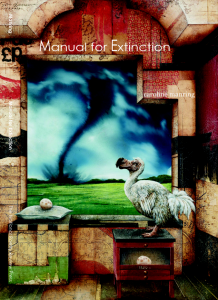 Manual for Extinction
Manual for Extinction
by Caroline Manring
The National Poetry Review Press, 2014
The earth in Manual for Extinction is a dour place where to be “alive was as good as dead.” The manual doubles as a field guide for understanding this wilderness-less mess, a contemporary big-boxed landscape that, lucky for us, Caroline Manring has surveyed with her poetic binoculars. Fans of “flotsam” will be pleased to find the word has survived End Times (hi flotsam!) and can be found in this book alongside lots of titles that start with the word how, as in “How to Go Extinct” and “How to Write a Debut Novel.” There are a few outliers, such as “The Cartographer’s Children Go Without Shoes,” an evolutionary meditation that invokes the proto-winged avian-ancestor, Archaeopteryx, in which “A fossil is deciding / whether to save us.” Manring demonstrates a cool familiarity with Biology while at the same time grappling with the paradox that Borges called exactitude in science. “A copy of a wolf & the wolf itself / are the same if you draw them both.”
A world of illustrated (aka dead) dodo birds, lost turkeys, and dilapidated human remains sounds shitty and scary but it is also quite literally what we’ve got. In place of live starlings and spring robins we might increasingly encounter the complexity of nature only in the complexity of research finding that predict diminishing populations of red-winged blackbirds, ruby-throated hummingbirds, and buffleheads alike. Manring writes in sympathy with these vanishing species, “I want less & less to be in present use.” Would that we were all to follow such a guide.
***
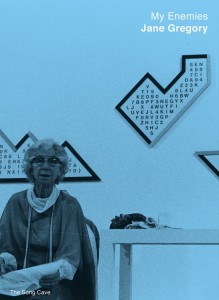 My Enemies
My Enemies
by Jane Gregory
The Song Cave, 2013
We’ve a lot to learn from My Enemies. As the title suggests, many things are often as much what they are as what they are not. Take, for example, Jane Gregory’s sonic yin and yang, “Cymbals / when washed up or out to sea are silent.” Much like the potential for both mute and crash held in tempered bell bronze, Gregory has set temporality in opposition to intuition, and by that I mean . . . listen to her ring like an animated slomotion gif of a Zildjian: “I recognize the tongue of the wolf / before it is in the wolf’s mouth.”
Wallace Stevens sez “Poems must resist the intelligence / almost successfully,” and My Enemies outmaneuvers the brain’s insistent cognition, which just cannot compute Jane Gregory. The many poems entitled “Book I Will Not Write” are, as announced, books never really written. But in the poetic summation of these non-books, the author has penned a must read.
Though unable to locate a single instance of “flotsam” inside this text, I found plenty of poetic words like “guncotton,” “ecdysis,” and “Proust.”
***
Peter Nowogrodzki lives in Hudson, NY
April 11th, 2014 / 10:00 am
Who’s Playing Doctor to the Physicians of the Soul?
“Poets are the physicians of the soul.”—Irving Layton, Canadian Nobel nominee for literature.
“She wouldn’t react that way to rape—you bet your life she wouldn’t. Along with the rest of her sex she’d lie back and enjoy it”—Irving Layton in private correspondence. Wild Gooseberries: The Selected Letters of Irving Layton (Toronto: Macmillan, 1989), 53.
***

Canadian Lit likes to think it’s known for being boring, or multicultural, or for surviving in the wilderness. It is hardly known at all, besides by a certain charming Scandinavian institute for Canadian Studies, and those non-Canucks who do know it exists prefer not to think about it. We have heard dull battle cries from other bookish people: “Can Lit isn’t literature”; “Or you could read an actual book” & “Don’t waste your time with that shit”. The Stephen Leacocks, Michael Ondaatjes, Margaret Atwoods, Alice Munros, Anne Carsons, Robertston Davies and Irving Laytons be damned; there’s nothing particularly Canadian about them, they just live north of the 49th. I don’t care to address those suckers of canonization’s long, evil phallus. “Tell us what to read!” they say. “Tell us what set of pseudo-conflicting opinions to harbor,” they murmur through their facile, troubled dreams of greatness. This letter is also not to the children of Canlit, those ‘iconoclasts’ who treat famous poets like demigods, and who worship in a side-chapel of the same institution of thinly-veiled brain-death. Keep your precious feelings, everybody, but leave discussions of taste to snobs who read.
Onward with a Grin: A Scene from Herzog by Saul Bellow
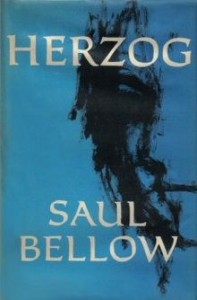 Herzog
Herzog
by Saul Bellow
Originally published by Viking Press, 1964
Buy from Amazon
In the lecture he delivered on the first day of classes at Wellesley College and Cornell University, Vladimir Nabokov tells of a Russian poet who was executed in 1921 because he would not stop smiling. Nikolai Gumilev died on an unknown day in August and, although his Soviet executioners did not know it, the crime for which he was first arrested was most certainly fabricated by their higher-ups. Still, Nabokov says, what truly irked “Lenin’s ruffians” was Gumilev’s steadfast smile, which he held even against the shock of the firing squad.
There is a cheerful morbidity in this anecdote that’s mixed from unpleasant truth, dark absurdity, and the inexorably joyous countenance of a man knowing he must die. There’s also a fundamental comedy of desperation on behalf of the Soviet goons who, at some point during the interrogations, must have flung up their arms up and said that if this poet won’t quit grinning then he has to go, so Gumilev unmindfully did.
This sort of comedy—with its helplessness, muddled terror, and insistent smile—is intertwined with the tragic in Saul Bellow’s fiction. Bellow intermingles sadness with laughter to create desperate comedies of hurt and self-humiliation, which attempt at first to allay pain through punchlines, by turning sorrow into farce. In art, the comic is usually superficial. Laughter is assigned the role of cure-all healer, a wheeler-and-dealer with the snake oil of stock gags and slapstick, where jokes are told to lighten the mood and reduce the gloom; yet Bellow pierces deeper.
For Bellow, laughter is not superficial, nor is it sorrow’s antithesis; for Bellow, laughter is the inherent human response to the incomprehensibility of life and all the flummoxing troubles therein. Comedy, then, becomes the involuntary sidekick that guides Bellow’s heroes who struggle closer to the crux of life’s inadequacies with vigor and a grin. The desperate comedy in Saul Bellow’s fiction forces the tragedy deeper by making it a little more palatable and accurate.
There’s a silly scene from Herzog that’s stuck in my mind for many years. It involves CPR and a monkey. Deep in the novel, Moses Herzog returns to Chicago to visit his young daughter who lives with his ex-wife. Before Herzog meets his daughter, he spends the night with an old friend, Luke Asphalter, a bachelor-zoologist who studies monkeys, and recently Herzog read in a magazine that when one of Asphalter’s subjects died he tried to revive it. “You must have been out of your mind, giving Rocco mouth-to-mouth respiration,” Herzog says. “That’s letting eccentricity go too far.” Asphalter says no one else’s death could have unraveled him the way Rocco’s did.
“You don’t mind if I smile,” Herzog apologized. “I can’t help it.”
“What else can you do?” Asphalter asks.
Is it mad to cherish an animal above all else? Is it insane that Asphalter says, “I was glad I had no wife or kids to hide these crying jags from,” because after Rocco died, he underwent a depression, quit showing at work, and let his beard grow so he’d better resembled the deceased simian? To Herzog it’s funny, devastating but funny, at least, he says, as “these painful emotional comedies” go.
It’s difficult to qualify the comedy in this scene—how it works, what to call it, what sort of reaction it requires; there are not one-word answers. There’s an element of black humor but it’s surpassed by Asphalter’s love and an element of absurdity that corrodes under the tears. There’s physical comedy in the memory of Asphalter attempting to resuscitate Rocco, though it seems less funny once Asphalter admits how much he needed the creature. The cartoon entertainment of a man giving CPR to a monkey mixes with the seriousness of loss. There’s death, loneliness, solitude, cordiality, and Moses Herzog’s continual bafflement as he tries to understand and fails. Asphalter says he’s been experimenting with different psychoanalytic treatments in an attempt to defeat his grief, but nothing helps. “Perhaps he was about to cry. I hope he won’t, thought Herzog. His heart went out to him,” Bellow writes. Then, as Asphalter describes how for one grief therapy session he pretended that he himself was dead—to overcome the sorrow of death by overcoming his own—Herzog thinks about Heidegger’s views and how “human life is far subtler than any of its models, even these ingenious German models. Do we need to study theories of fear and anguish?” This adds a tinge of humorous humility. The grand thinkers, as masterful as they may be, have no words to assuage the awfulness of the death of Rocco the monkey.
“You don’t mind if I smile?” “What else can you do?”
This exchange has guiding force. It’s the force of a smile that protrudes through, a smile mixed a startled, helpless laugh. The scene encapsulates the necessity of laughter, the deep soul-grunt of relief that laughter offers. Pain, loneliness, loss—these casual horrors are held at bay by the rebellious power of Herzog’s chuckle and grin. Laughter can stand up to misery and darkness; laughter is often an act of defiance. Shockingly, the worst of life can be shrugged off with a silly grin. “What else can you do?” These words have echoed in my mind for a long time. It’s a simple exchange, the kind that you could overhear on a bus or have with a friend about something very trivial or serious. Don’t mind if I smile? What else can you do? The facial expression that goes with “What else can you do?” is so particularly human it’s stunning.
Nabokov once described the Chekhovian hero as “a good man who cannot make good,” someone who “stumbles because he is staring at the stars.” One cold night in Chicago a while ago, Moses Herzog crashed on his friend’s couch. And there they were, two injured men laughing, two men who did their best but since when has that ever been good enough? The stars burn with infinite indifference to the plight of dreamers. The stars are beautiful but they cannot guide us.
“Unexpected intrusions of beauty. This is what life is,” Herzog thinks later, while he fills a sink with water and notices the “gray light” of the bathroom and the “almost homogenous whiteness” of the oval basin. The same holds for humor. Unexpected intrusions of laughter, of smiles, are what life is. They make the daily struggle slightly more bearable, knowing that at some point a chuckle, hearty haha, or quiet smile will arrive. Laughter is the necessary response to inexplicable loss and inevitable decay, a required reaction to all the regular and extravagant hurts that mark our days. What else can you do? Out of nowhere sometimes, like a ferocious roar, laughter will burst forth to remind us we are so fiercely, foolishly alive.
***
Alex Kalamaroff is a 26-year-old writer living in Boston. He works on the administrative team of a Boston Public Schools high school. You can read his other writings here or follow him on twitter @alexkalamaroff.
February 10th, 2014 / 10:00 am
R.I.P. Miklós Jancsó
The great Hungarian filmmaker Miklós Jancsó passed away on 31 Jan; he was 92 years old. (The New York Times obit is here.) I first learned about Jancsó from David Bordwell, who wrote a detailed analysis of the man’s 1969 film The Confrontation in Narration in the Fiction Film (some of which you can read here). That film has been difficult to find (though there’s an unsubbed copy at YouTube), but I was able to track down The Round-Up (1966); The Red and the White (1967); Elektra, My Love (1974); and what would quickly become one of my favorite films, Red Psalm (1972):
(Here‘s a detailed essay by Raymond Durgnat of that film.)
Jancsó is perhaps best known for his work in the late 60s and early 70s, which saw him systematically exploring the question of how few takes he could use to make a film, while simultaneously exploring how complex those takes could be in terms of staging. The 87-minute-long Red Psalm consists of 27 elaborately designed shots (see the above clip for an example); in this way, the film was a forerunner of Aleksandr Sokurov’s 2002 single-take feature Russian Ark, as well as Alfonso Cuarón’s recent Gravity. (Cuarón named Jancsó as his primary influence in this Empire interview). Fellow Hungarian Béla Tarr was also much influenced by the man’s work, and has called him “the greatest Hungarian director of all time.”
Despite Jancsó’s significant artistic achievements, he’s been unfairly overlooked by most US film distributors. But some of his work can be found both online and on disc. It’s well worth tracking down.
Boys Who Kill: Nathan Leopold and Richard Loeb
The third installment of Boys Who Kill stars Nathan Leopold (right) and Richard Loeb (left). On 21 May 1924 in Chicago, Nathan and Richard kidnapped and killed a 14-year-old boy.
Nathan and Richard each had daddies who amassed mountains of money. Nathan’s daddy owned one of the biggest shipping business in the country and Richard’s daddy was the vice president of Sears Roebuck. But the wealth that surrounded them didn’t dispel boredom. The two didn’t want money, they aimed for fame, sensationalism, and transgression. One of Richard’s favorite dreams had him as a notorious criminal who was beat and whipped in public, with girls and boys arriving in droves to express their mixture of awe, sympathy, and disgust. As for Nathan, he envisioned himself as a king’s favorite slave. One day, Nathan saved the king’s life, and the king offered to set him free, but, being loyal, Nathan declined. Both fantasies are rather Jean Genet: they are sumptuous, romantic, and somewhat sordid.
Like that French prison boy, Nathan and Richard carried out many crimes, including stealing automobiles and smashing bricks through windows. Mostly, though, the crimes were initiated by Richard, who insisted that Nathan come along to serve as an audience. After the two stole a typewriter and other possessions from Richard’s former frat house at the University of Michigan, Nathan became upset at Richard because the latter wasn’t wasn’t having enough xxx with the former.
Nathan and Richard’s friendship/boyfriendship sort of resembles the typical depiction (though it’s likely bullcrap) of Eric and Dylan. Eric is the aggressor and Dylan is the follower. Eric constructed NBK and Dylan just acquiesced. It’s also been rumored that Eric and Dylan liked boys (though that’s definitely bullcrap). Columbine jocks told the media that the two BFFs were a part of the Trench Coat Mafia, whose members touched one another in hallways and convened group showers. In Gus Van Sant’s Elephant, the two Columbine-esque boys get into the shower together and kiss and maybe do other things before they commit their high school massacre.
But Nathan and Richard really did like boys. Though Richard was perceived as the leader, he was the one who took it in the tushy. That this is so, sort of confounds how boys who take in the tushy are assessed. Richard engineered many crimes, including murder, so maybe boys who take in the tushy aren’t all basic bitches after all. Another hypothetical reason for why Richard took it in the tushy is, as he declared to friends, he didn’t need xxx. Richard was beyond lust and all of that other stuff that occupies the ironic minds of 20-something Brooklyners day and night. The symbolism about taking it in the tushy had no effect on him, as he only cared about a life of crime.
Interview With Luis Panini
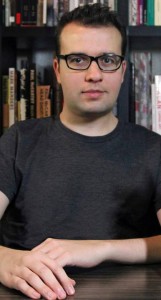 Luis Panini is one of the most talented writers you’ve never heard of. With writing that recalls the best of Franz Kafka, Lydia Davis, David Foster Wallace, and Julio Cortázar, it is a regret that his writing can not be read in English (until now! see below). I recently sat in on a class at CalArts where he was a special guest in my friend Laura Vena’s class on Latin American literature, and it was a huge pleasure to hear him talk about his writing and thought processes. Laura Vena translated a few of his short stories (or fragments) into English, the results of which can be found below, and so I’m hugely happy and excited to share this interview here and debut these new translations of his work into English.
Luis Panini is one of the most talented writers you’ve never heard of. With writing that recalls the best of Franz Kafka, Lydia Davis, David Foster Wallace, and Julio Cortázar, it is a regret that his writing can not be read in English (until now! see below). I recently sat in on a class at CalArts where he was a special guest in my friend Laura Vena’s class on Latin American literature, and it was a huge pleasure to hear him talk about his writing and thought processes. Laura Vena translated a few of his short stories (or fragments) into English, the results of which can be found below, and so I’m hugely happy and excited to share this interview here and debut these new translations of his work into English.
Janice Lee: In your other life, you’re an architect and furniture designer. I’m interested in how this work and mode of thinking influences your stories. For example, the preciseness of your language, the constructedness of your stories as rigid and stable structures, your attention to spatial details and spatial relationships, and the existence of people and objects in physical environments rather than in relation to each other.
Luis Panini: My academic background has not only influenced the way in which I think about stories before I actually write them but also it has made me think about overall structures when I am constructing (not writing) a book, whether is a collection of short fiction, a novel, a book of poems or some piece of writing that does not necessarily falls into these ankylosing categories. Spatial awareness is very important for me since it is ultimately where the “game is played” and this is why I frequently try to inject some sort of symbolic meaning to both, the spaces my characters inhabit and the objects they come in contact with. In a way, what I am trying to accomplish is to integrate these “architectural objects” into the narrative in such a way that these become as important as the characters or the story itself. It is about translating the mere functionality of a space or an object into an emotional component in the writing process or how this space or object is acknowledged and assimilated by the reader. Duchamp’s “Fountain” comes to mind. He managed to transform a simple urinal into an object charged with many layers of meaning by placing it within the confines of a “sacred space.” Outside the museum, Duchamp’s piece is nothing but a urinal. Inside the museum is everything but a urinal because the reading conditions of this object have been transgressed. This is the sort of relationships I like to establish between my characters and the space they move about.
JL: You’ve described your stories as vignettes or fragments, and I think they operate in this way, but too, at the same time, they seem like such self-contained and intentionally built structures that do have set boundaries. Can you talk a bit more about the general shape of your individual stories?
LP: I did refer to those texts (the ones collected in my second book) as vignettes or fragments because that is truly what these are. They are absolutely self-contained pieces of writing. I like to think that the most interesting building block in writing is not the sentence, the paragraph, the chapter, etc. but the fragment, because a fragment does not require a beginning or an end, it does not need to tell a whole story to work, it does not have to acknowledge the fragment that precedes it or follows it and I find this to be truly liberating, a sense that I do not get when I take a different approach. About a year or two ago I finished writing a book that deals with memory and it is comprised of more than one hundred fragments. There are two versions of that book. In one version the fragments follow a chronological order of events and in the other version the fragments appear in the order in which they were written, the order in which I remembered a loved one who died recently. I chose to write about that story through fragments because in a way I wanted to emulate the mechanisms of memory and a fragmentary approach made perfect sense since I could experiment with the elasticity of the overall structure (or lack of one) by allowing a virtually infinite number of permutations. This also allowed me to set very strict boundaries on a fragment bases that I had to respect as I was writing each line. Every time I deviated in any way from those boundaries, the fragment did not work. It felt like an ill-conceived part of a whole. Through this method of writing I learned about the shape of not just individual stories but also how these can be connected in a book and how they interact among themselves by borrowing, cannibalizing from each other, etc. A book composed of fragments can be dozens of different books, only limited by the sequence you end up choosing.
JL: I know you are a Béla Tarr fan too, and I find that there are some resonances in your work with Tarr’s fans. For example, the focus in your stories is often on a person’s existence in a space or situation, and the story settles in on the details of the environment, constructing a scene that becomes a sort of story, rather than a story that is based on action and resolution. This reminds me of the indifference of the camera in Tarr’s films too, where often the setting is there before a character enters, and remains there after the character is gone. What are your thoughts on this observation?
LP: Sometimes I think that filmmakers are the ones who truly influence my creative process and writing methods, much more than literature in general or specific writers and books, and this has nothing to do with the fact that I live in Los Angeles, a city in which if you mention that you are a writer most people immediately ask you what screenplays have you written. Béla Tarr is one of these auteurs (I can’t tell you how much I enjoyed seeing that old man peeling potatoes in “The Turin Horse”), but also I am fascinated with the way other directors choose to tell stories, like Michael Haneke, Yorgos Lanthimos, and my personal favorite Ruben Östlund. I am not trying to say that my literary work has a cinematic quality or that it could easily be translated onto the screen, but this element becomes quite obvious since I tend to favor heterodiegetic narrators in most of my texts. I like to take it to the extreme, turning them into machine-like narrators which can be perceived as actual cameras panning through multiple rooms in a residence to create some sort of long shot composed by zoom-ins, abrupt cuts, blurs, etc. My vignette titled “The Event” is an example of this. After the character has “disappeared” in a very tragic way the camera goes back into the apartment where it all began and stays in recording mode to capture the solitude of the space, which to me is far more important than the demise of the actual character. In another vignette the narrator also acts as a camera that moves inside of a mansion to capture many of the possessions of a lonely man dying of complications related to an immunological disease. I was not interested in that man’s story specifically, but in how I could construct one by describing the pieces of furniture and ornaments he owns, the art hanging on his walls, and the materials and finishes of his home. I guess by doing this I am trying to illustrate some sort of terror that sometimes keeps me awake at night, the fact that after one dies everything else remains in its place, unaltered, because we are that insignificant. And it is this sense of pervasive malaise what informs most of my writing.
JL: I’m affected deeply by level of compassion and human dignity present in Tarr’s fans. On this subject, Andras Balint Kovacs writes:
“The man, whose philosophy despises ‘humanist’ feelings like compassion and pity, suddenly and certainly unwillingly, manifests the deepest compassion for a helpless living being, a beaten horse. This event, says Krasznahorkai, is ‘the flashing recognition of a tragic error: after such a long and painful combat, this time it was Nietzsche’s persona who said no to Nietzsche’s thoughts that are particularly infernal in their consequences.’ This is the example which leads to a conclusion about the universality of this feeling: ‘if not today, then tomorrow… or ten, or thirty years from now. At the latest, in Turin.’ … an attitude or an approach to human conditions, which Tarr fundamentally shares with Krasznahorkai… Both authors have a fundamentally compassionate attitude toward human helplessness and suffering in whatever situation it may manifest itself, and of whatever antecedent it may be the result.”
In Tarr films, compassion can exist without moral judgment, or, in other words, “In the Tarr films human dignity is not based on morality. It is based on the fact that in spite of their absolutely hopeless and desperate situations the characters remain what they are, however low what they are brings them.”
This simultaneous closeness and distancing, this empathy is ever-present in your stories for me too. For example, in “Mathematical Certainty,” there is a deep care in the description of the hat, but also in the generous curiosity afforded to the man with the brain tumor. I also recently heard Lydia Davis talk about description, and said something like, “In order to describe something, you have to love it. Even if it’s ugly, like an old shoe, you have to love it in a way to really describe it.” The preciseness of your language and the kind of curiosity afforded by such a detail as the length between the interior wall of the hat and the tumor, seems like a generous gesture in a way. What are your thoughts?
LP: I believe empathy and compassion is what drove me to write the vignettes included in my second book, as strange as that may sound given the dark nature of the overall subject matter of those texts, which is ill will. In fact, I can pinpoint the exact moment that acted as the catalyst. Back in 2006 there was a terrible brush fire, which consumed an enormous area near Los Angeles. For some reason that I yet have to comprehend a news show chose to broadcast a recording with no “viewer discretion advised” warning beforehand. I saw the body of a fallen hare partly carbonized. It was still moving, shaking the rear legs, convulsing, agonizing. And it affected me so much because animal suffering is something I simply cannot deal with. So this visceral reaction prompted me to explore this feeling in different ways, in fact so many that soon became a book about ill will. Ill will towards animals, patients with terminal diseases, sexual partners, art, even towards the reader. The main character in “Mathematical Certainty” is a man who soon will die of a brain tumor he has chosen not to have surgically removed. Instead, he decides to buy a white hat to conceal, maybe in an unconscious way, this organic tissue developing inside of him. Growing up in a predominantly catholic environment I heard many people say that the real reason why a man or a woman got cancer was the result of divine punishment, as if sinful behavior (whatever that means) could trigger it. So, in a way, that particular vignette is about religious ill will, the supposed shame caused by the disease, thus the comparison between the hat and a crown of thorns. Again, I was not too interested in the life of this character, but in presenting a juxtaposition of elements, such as a man fully dressed in white with something truly dark growing inside of his skull, and more so in determining the distance between the interior wall of the hat and the tumor, because those particularities or insignificances are what fuel my desire to write. I don’t want to write about the victims of a serial killer or the reasoning behind his actions, instead I want to write about the way in which this terrible person peels potatoes.
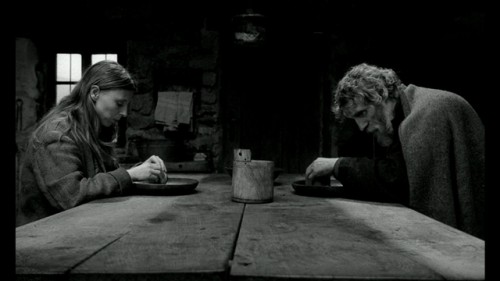
January 15th, 2014 / 10:00 am
The Tales by Jessica Bozek
 The Tales
The Tales
by Jessica Bozek
Les Figues, December 2013
76 pages / $15 Buy from Les Figues Press or SPD
Jessica Bozek calls her spurts of narrative in The Tales poems, but they aren’t, quite. Except for the sprawling middle section, Bozek’s short book is made up of justified blocks of prose such as this:
THE SAVING:
A FAIRY TALE
The loon’s lesson.
Now under funerary green, the citizens are cut off from the surrounding lands. A loon teaches them that they can dive down into their own small lake and come up in another lake. The cost of this transport is that all communication must happen underground.
The spurts trace the trajectory of someone called “The Lone Survivor” after a cataclysmic war known by its aggressors as Operation Sleep. The Lone Survivor makes his way into the world of the attacking nation, seeing visions of thriving life as he tries to hold onto his own past. From what I can see, he is eventually banished to a sort of reservation/museum-type installation, where reparations are attempted as time progresses. The political implications here are explicit, and welcome. But the value of the tales is mostly, I think, in their language, the way Bozek tells this story. Not through poems exactly. Nor, though, through fiction.
Of course, Bozek can call her work whatever she wants to call it. Poetry. Prose. Visual art. (The book is, indeed, beautiful, printed with all the white space that such short blocks of writing require, black endpaper, a red and gold Russian starkness on the front and back covers with a typeface of the same ilk.) But The Tales reminds me more of the hybrid work I am used to seeing from Tarpaulin Sky, in books like Kim Gek Lin Short’s China Cowboy and Sarah Goldstein’s Fables. In fact, The Tales earned its publication by winning the 2012 NOS (Not Otherwise Specified) Contest with Les Figues Press.
Bozek’s work here strikes me as one in a string of very compelling books of very short prose that are both language- and narrative- oriented. Such writing, I think, performs its work in a different space than poetry or prose. Where poetry, I would argue, creates much its value in the relationship between words, and more traditional fiction creates value in the relationship between paragraphs and events, Bozek’s hybrid vignettes seems to do their work between sentences, redefining causation, its images evoked with some clarity and yet set beside other images that would not “normally” come after them. The effect is a sort of circling-around, an attempt to penetrate the ineffable that is almost Zen-like. The shorts’ slow spiral tends toward some wordless meaning, I envision, drawing a picture in the readerly mind of a world with qualities so magical as to be literally inexplicable.
Part of this world is what we understand as dystopian, in the tradition suggested by the preface on “Operation Sleep,” by the book design, by words like “reparations” and “the State Museum for the Justification of Military Action.” But there’s something in the prose that is beyond words, too. In this vein—that, perhaps, of poetry—it is important to recognize that priority is given not to the narrative overall but to the effect of individual pieces. Symmetry is not a priority in this volume, and I am glad for it. Each piece stands for itself.
Which may be one reason why Bozek uses the word “poems” to describe what she’s written here. Another reason, I might guess, is her sheer personal investment in each piece, the compression of so much thought and feeling into so little language. The text of the book is followed by a full complement of back matter, sometimes outwording the vignettes themselves, as with one of the many with the title “The Lone Survivor’s Tale”:
I shed clothes in remembrance. The braided cables on my sweater unravel from the neck as I wind through the tree trunks, making a cyan tangle. When there is little left, I bite down to keep the cuffs.
Jessica Bozek explains, in her notes:
As glad as I was to have these iterations, I was even happier without them, for it is exactly the gaps in The Tales’ information that make it so compelling. The book’s middle third, the only section written in what would seem visually to be more explicitly “poetic,” ensues when the Lone Survivor “unspool[s] the words of those lost.” Across a series of mostly blank pages are scattered fragments of images and speech, remnants of some mostly erased world. The blank, here, is visual. In the rest of The Tales, it is conceptual, a blank in mental imagery, evoked in the way of the koan. So that we simply believe Bozek when she says:
I have begun weaving nests from the fallen hair on the floorboards and furniture. I leave these nests on high things outside. I want to be useful to the birds.
There is something more here, some ache, some weird impulse of energy and sadness toward a relevance that will never be relevant, not even to the few birds that remain to the Lone Survivor as companions. Not to mention the sheer image of a nest of fallen hair, wispy and whisked away in seconds by the wind.
But then, again: it doesn’t sound as good when you try to explain it. Which was why I was so happy to let Bozek’s Tales just breathe.
***
Dennis James Sweeney‘s recent work has appeared or is forthcoming in Fractured West, Sundog Lit, Whole Beast Rag, and Word For/Word. Find him at dennisjamessweeney.com.
December 16th, 2013 / 12:00 pm
Chaser 2, a game review

One of the things I’m noticing lately is that I’m, I think not just a little sick, but completely sick of narrative video games. Or at least I am sick of games that have big, ambitious narratives.
Because I’m sick of big, ambitious narrative video games, I’ve found myself playing discrete-narrative, gameplay-centric little indie games. And old games.
So that’s why I’ve been thinking about Chaser 2 again. READ MORE >
December 12th, 2013 / 10:00 am



